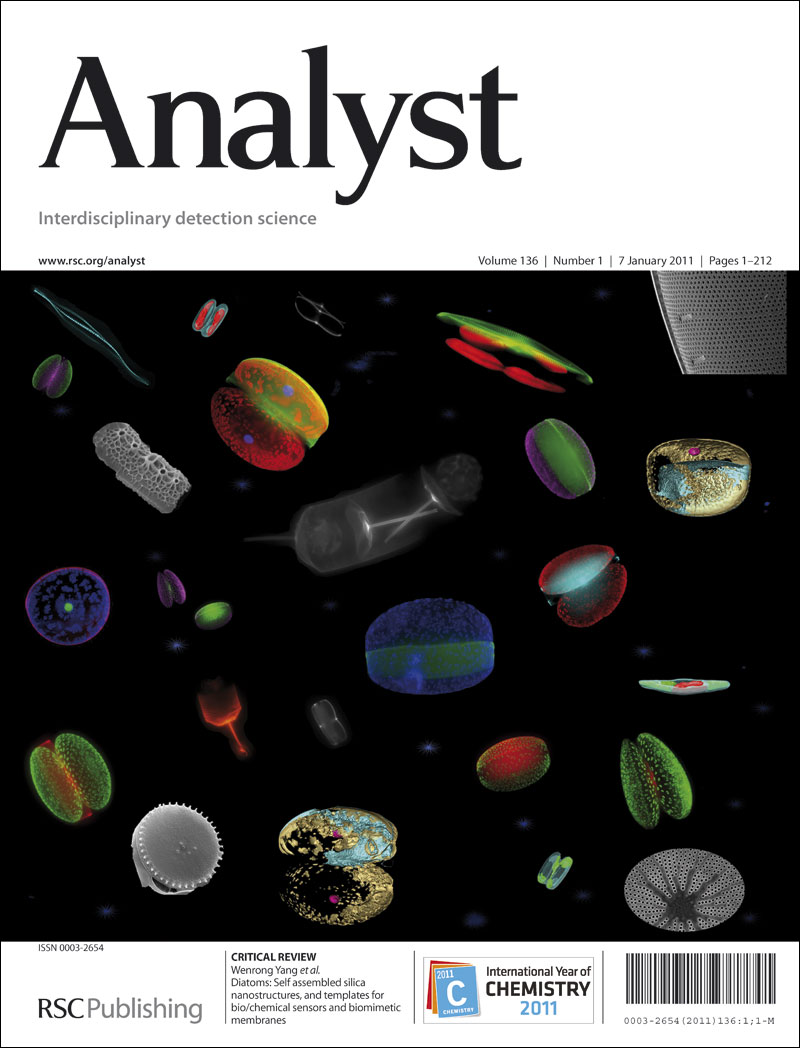ESIPT-active fluorescent probes for ratiometric analysis of carbonate ions in aqueous media: structural modifications for enhanced selectivity and response.
IF 3.3
3区 化学
Q2 CHEMISTRY, ANALYTICAL
引用次数: 0
Abstract
This study focuses on the design and synthesis of two ESIPT-active fluorescent probes that differ in the position of the hydroxyl group. The isomer with the hydroxyl group at the ortho position in compound 1 exhibited a large population of the keto tautomer in equilibrium, forming more compact nanoaggregates in aqueous media. In contrast, the enol form was predominant in compound 2, which has the hydroxyl group at the terminal position, leading to significantly larger aggregate sizes compared to the first probe. Both compounds demonstrated a ratiometric color-changing response with carbonate ions, accompanied by a turn-on fluorescence response. Mechanistic studies revealed that hydrogen bonding (or possible deprotonation) induced by carbonate ions influenced the keto-enol equilibrium and conformational flexibility, which affected both the optical properties and aggregation behavior of the probes. Comparative analysis showed that compound 1 had a superior response towards carbonate ions compared to probe 2. The position of the hydroxyl group altered the binding cleft available for carbonate ions. Furthermore, the naphthyl-substituted analogue of probe 1 formed larger aggregates and exhibited a stronger response to carbonate ions than probe 1 itself. Cross-reactivity studies confirmed the high selectivity of compound 1 for carbonate ions, with minimal interference from other anions. These results motivated the use of the current system for analyzing carbonate ions in natural water samples collected from the laboratory tap and nearby ponds. The high recovery rates and low standard deviation confirmed the suitability of this system for the quantitative analysis of carbonate in real-life samples.用于水介质中碳酸盐离子比率分析的esipt活性荧光探针:结构修饰以增强选择性和响应。
本研究的重点是设计和合成两种具有esipt活性的荧光探针,它们的羟基位置不同。化合物1中羟基位于邻位的异构体在平衡状态下显示出大量酮互变异构体,在水介质中形成更致密的纳米聚集体。相比之下,烯醇形式在化合物2中占主导地位,其羟基位于末端位置,导致与第一个探针相比,聚集尺寸显着更大。两种化合物都表现出与碳酸盐离子的比例变色反应,并伴有开启荧光反应。机理研究表明,碳酸盐离子诱导的氢键(或可能的去质子化)影响了酮烯平衡和构象柔韧性,从而影响了探针的光学性质和聚集行为。对比分析表明,化合物1对碳酸盐离子的响应优于探针2。羟基的位置改变了碳酸盐离子的结合间隙。此外,探针1的萘取代类似物形成了更大的聚集体,对碳酸盐离子的响应比探针1本身更强。交叉反应性研究证实了化合物1对碳酸盐离子的高选择性,其他阴离子的干扰最小。这些结果促使使用当前的系统来分析从实验室水龙头和附近池塘收集的自然水样中的碳酸盐离子。高回收率和低标准偏差证实了该系统对实际样品中碳酸盐的定量分析的适用性。
本文章由计算机程序翻译,如有差异,请以英文原文为准。
求助全文
约1分钟内获得全文
求助全文
来源期刊

Analyst
化学-分析化学
CiteScore
7.80
自引率
4.80%
发文量
636
审稿时长
1.9 months
期刊介绍:
"Analyst" journal is the home of premier fundamental discoveries, inventions and applications in the analytical and bioanalytical sciences.
 求助内容:
求助内容: 应助结果提醒方式:
应助结果提醒方式:


